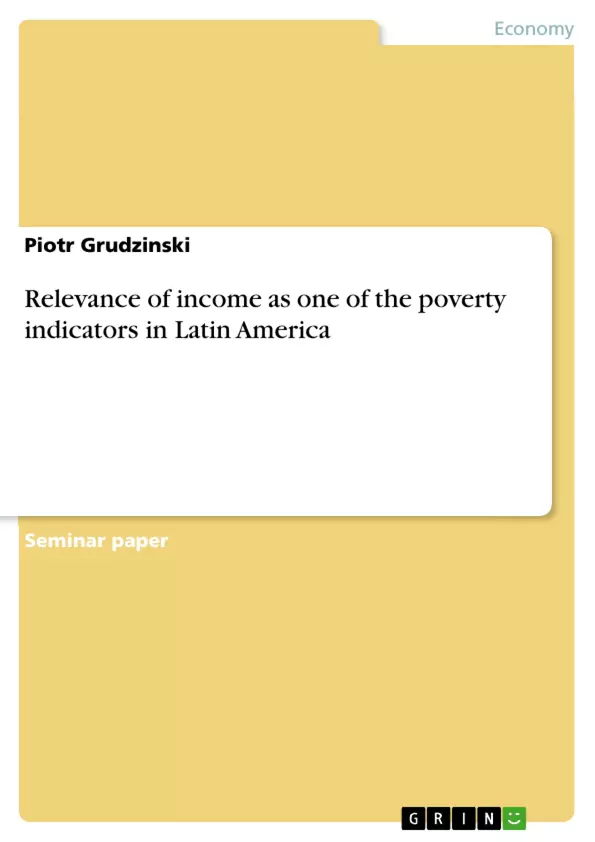Poverty has been and is a main issue in most countries, in particular in Latin America. Antipoverty efforts have increasing priority among socio-political objectives. Both internally in so-called “poor countries“ themselves, as internationally within organizations involved in anti-poverty policies. As a consequence both groups have to define what is poverty, how to measure it? What are the best indicators of poverty? Which statistics must be used to draw a clear picture and conclusions? This is a very complex process, as it touches both tangible and less tangible indicators. Income/Consumption Method, Household income distribution, Household Expenditures, Headcount Ratio, etc. are keywords rather for the mere economic aspect. Income/Consumption distribution has the widest use as a poverty marker. The other methods focus on social inequalities like: access to social institutions, social security, differences in social legitimacy and status, inequalities of freedom and social and political participation. Focus and Layout Having the widest use due to its tangibility and measurability, income/consumption is not a perfect and only poverty indicator. Most analyses of poverty in Latin America refer to income inequality, as other perceptions i.e. due to social exclusion and impossibility of certain populations accessing key social services, etc, constitute a large part of the story about poverty in Latin America. On the following pages, significant impact will be put on poverty markers that are sometimes treated as less important. This paper will present a framework of aspects that make the poverty in Latin America a lingering, persevering state. The relevance of the income distribution in comparison with other poverty indicators across Latin America will be shown. In other words, to which extent can poverty in Latin America be explained by inequalities of income distribution and to which by other dimensions. Firstly as the “non plus ultra”, the ECLAC approach to poverty measurement will be shown. Later, for the paper purposes, a distinction between the “economic poverty indicators” and “sociopolitical poverty indicators” will be made. Country classification will be presented accordingly. Countries of Brazil and Peru will be taken as examples. Further on scope and importance of both poverty dimensions will be assessed. Finally a summary and conclusions sections will complete the paper. [...]
Inhaltsverzeichnis (Table of Contents)
- 1. Introduction
- 2. What is Poverty? Measuring Methodologies
- 2.1 Economic Poverty Indicators (narrow, direct measures)
- 2.1.1 Income or consumption insufficiency method. Poverty income lines
- 2.1.2 Relative Poverty
- 2.1.3 Economic Poverty Types/Dimensions in the cases of Brazil and Peru
- 2.2. Socio-Political Poverty Indicators (broad, indirect measures)
- 2.2.1 The Unmet Basic Needs (UBN)
- 2.2.2 Poverty as a lack of equality
- 2.2.3 Socio-political Poverty Types/Dimensions in the cases of Brazil and Peru
- 3. Economic vs. Socio-political view of Poverty
- 4. Conclusions
Zielsetzung und Themenschwerpunkte (Objectives and Key Themes)
This paper aims to analyze the relevance of income as a poverty indicator in Latin America, exploring its strengths and limitations in comparison to other poverty measures. It investigates the complex nature of poverty and examines different methodologies for its measurement.
- The multifaceted nature of poverty in Latin America.
- Economic poverty indicators, such as income and consumption insufficiency, and their limitations.
- Socio-political poverty indicators, focusing on access to social services, social security, and political participation.
- The interplay between economic and socio-political dimensions of poverty.
- The relevance of income distribution as a poverty indicator in the context of Latin America.
Zusammenfassung der Kapitel (Chapter Summaries)
- Chapter 1: Introduction: This chapter introduces the problem of poverty in Latin America and the need for accurate and comprehensive poverty measurement. It highlights the complexity of poverty and the importance of considering both economic and socio-political indicators.
- Chapter 2: What is Poverty? Measuring Methodologies: This chapter delves into the various methods for measuring poverty, focusing on both economic and socio-political indicators. It discusses the limitations of income/consumption insufficiency methods and introduces the concept of relative poverty.
- Chapter 3: Economic vs. Socio-political view of Poverty: This chapter compares and contrasts the economic and socio-political perspectives on poverty, highlighting their respective strengths and weaknesses. It explores the importance of considering both dimensions for a complete understanding of poverty.
Schlüsselwörter (Keywords)
This paper explores the concept of poverty in Latin America, examining its various dimensions and measurement methodologies. It focuses on economic poverty indicators, including income and consumption insufficiency, and socio-political indicators, such as access to social services, social security, and political participation. The paper also investigates the relevance of income distribution as a poverty indicator within the specific context of Latin America.
- Quote paper
- Piotr Grudzinski (Author), 2006, Relevance of income as one of the poverty indicators in Latin America, Munich, GRIN Verlag, https://www.grin.com/document/58968



